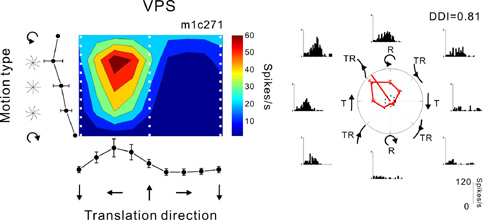Time:2016-04-22
In daily life, our complex self-motion trajectories through the environment (e.g. making turns whiledriving) typically contain two independent components: the translation and the rotation of the body/head in space. In our inner ears, the peripheral vestibular system has evolved two sets of organs specifically encoding one of these two motion components: the otoliths detect translations, and the semicircular canalsdetect rotations. Despite this seemingly perfect bioengineering mechanism, these initially independentsignals have been found tofrequently converge at the level of single neurons in multiple cortical areas. The nature and function of this convergence remains puzzling to date.
In a recent study published online on April 21st in Cell reports, Dr. GU's lab at the Institute of Neuroscience, Chinese Academy of Sciences, unveiled that single neurons in three cortical areas: the dorsal portion of the medial superior temporal area (MSTd), ventral intraparietal area (VIP), and visual posterior sylvian fissure (VPS), can integrate the translation and rotation signals with linear weights to represent curvilinear self-motion perception.
Specifically, graduate student CHENG Zhixian and Dr. GU used a motion platform to generate three types of motion: (1) a translation-only condition where only the otoliths were stimulated; (2) a rotation-only condition where only the horizontal semicircular canals were stimulated; and (3) a curvilinear motion condition where the otoliths and the horizontal canals were stimulated simultaneously. They then recorded extracellular activity from 308 well-isolated single neurons in the 3 cortical areas from two macaque monkeys. By using this paradigm, CHENG and GU found that roughly20% of cells were significantly tuned to both of the translation and rotation stimuli, and they werethus defined as convergent cells. Unlike the translation-only or rotation-only cells, the convergent cells exhibit stronger responses during the curvilinear motion condition. Interestingly, convergent cells respond to real and illusory curvilinear self-motion in an analogous way, which accounts for the behavior as reported in previous psychophysical studies. Finally, all these results are similar across the investigated areas, indicating that the representation of curvilinear self-motion perception is widely distributed in the primate sensory cortex.
This work was supported by funding from the National Natural Science Foundation of China Project (grant number: 31471048); the Strategic Priority Research Program of the Chinese Academy of Sciences (Y51HN11421); and the Recruitment Program of Global Youth Experts to Dr. GU Yong.

Figure legend: A convergent cell from area VPS. The left contour map shows the mean firing rate (color) as a function of translation directions in the horizontal plane (x-axis) and rotation conditions (y-axis). White dashed lines indicate the data extracted and plotted in the radial coordinate in the right panels. Solid straight lines represent preferred motion type computed from the vector sum.
 附件下载:
附件下载: